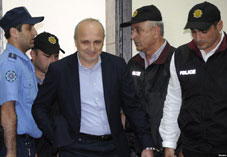
Whose interests does the Densus report on May 26 events reflect?
By Gvantsa Gabekhadze
Wednesday, August 14
Lawyers of Vano Merabishvili demand to change the pre-trial detainment for the former Minister of Internal Affairs (MIA) on the basis of the report made by the Densus Group concerning the May 26, 2011 dispersal of the opposition rally.
Opposition leaders organizing the rally speak on the partiality of the report, stating that the document was made through mediation of the former government of Georgia. Georgian NGOs claim that there are certain issues in the report that raise questions. The prosecutor’s office that delivered the report to Merabishvili’s lawyers stressed that the document makes the charge against Merabishvili heavier. However, the document cannot be used as newly revealed evidence.
On August12, 2013, the NGO Free Zone released a U.S. report on the May 26 events. The organization informs that the document they obtained is commissioned by the US Department of State and completed by the Densus Group Review Team. The report was prepared in 2011.
The report says that the protestors used metal crowd control barriers to block Rustiveli Avenue to the north and south of the Parliament building, reinforcing the barrier by linking them with metal cables anchored to street furniture. “This action can be interpreted as a direct provocation to force police into direct action, as Rustaveli Avenue was to host the Independence Day Parade the next day, on May 26th,” the report says.
The report also claims that the protesters were armed with sticks and improvised shields. There is also evidence of other projectiles and the so-called Molotov cocktails being available to the protestors and intelligence that there were some in the crowd carrying legally held firearms.
The summary of the report says that the tactical plan and the intelligence analysis were sound and correctly and properly briefed to officers in advance of the dispersal operation. The specialist tactic of cutting and removing the southern barrier to allow controlled egress was appropriate and successful. The arrest strategy was also well prepared.
However, the document reads that the general management carried out by police, mass demonstration field command and planning needs improvement. The report also says that people were injured due to the actions of police and several police officers were charged. However, without indication who they were and how they were punished. The reporters say that 27 policemen were also injured during the rally.
Merabishvili and the members of the UNM say that the report proves that the dispersal of the rally was undertaken through the norms recognized by the international community. Merabishvili also said that the report had no political connotation and its aim was the impartial description of situation.
“That is why the report has not been released until now,” Merabishvili said.
The Prosecutor’s Office states that they really delivered the report to Merabishvili’s lawyers. According to the office, the report cannot be taken as newly revealed evidence.
The office states that the report proves that illegal commands were delivered by Merabishvili that caused injures to tens of Georgian citizens.
“It is also noteworthy that the reporters used those materials that were given to them by the Interior Ministry in 2011, the information in particular cases were false,” the Prosecutor’s Office says, adding that 16 employees of MIA were punished, when some of them did not participate in dispersion of rally at all.
“It has not been announced in which departments the officers served and for what violations they were punished,” the prosecutor’s office states.
One of the leaders of the opposition rally of May 26, Irakli Batiashvili, states that Densus is not a state organization, it is a private firm that had been assisting the UNM government for years, taking a certain amount of money from the former Georgian government. “Thus, their report cannot be impartial and should not be used as an evidence,” Batiashvili states.
Member of Georgian Young Lawyers Association (GYLA) Giorgi Gotsiridze, the GYLA prepared a report concerning the issue through questioning all parts of the case, taking all saved materials over the issue into account.
“Existence of Molotov cocktails at the rally was not confirmed by us, as well as an alternative exit way that would have enabled the protesters to leave the scene. Protesters were circled by police officers and beaten up. The operation was not well-prepared as well, as there are videos that display overuse of force from police towards already detained people,” Gotsiridze says.
Former Public Defender Giorgi Tughushi also pointed out several facts of the rally. According to him, Molotov cocktails were not used during the rally and tens of people were beaten during and after the rally.

